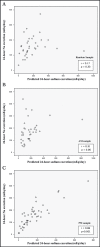Estimation of 24-hour sodium excretion from spot urine samples
- PMID: 20433530
- PMCID: PMC8816459
- DOI: 10.1111/j.1751-7176.2009.00241.x
Estimation of 24-hour sodium excretion from spot urine samples
Abstract
Despite the effects of sodium intake on blood pressure and on response to antihypertensive medication, sodium intake is rarely monitored in clinical practice. The current method, the 24-hour urine collection for sodium excretion, is cumbersome, often incorrectly performed, and not commonly ordered. Further, its results have limited meaning because of the substantial day-to-day variation in sodium intake. A spot urine test to enable convenient, inexpensive, and serial monitoring of sodium excretion would be desirable. In this study, the accuracy of predicting 24-hour sodium excretion from a spot urine sample was assessed. The urine sodium/creatinine ratio was determined from the following urine samples: an "AM sample," submitted at the beginning of the 24-hour urine collection; a "PM sample" collected in the later afternoon/early evening before dinner, at roughly the midpoint of the collection; and a "random sample," collected after its completion. The ratio was then corrected for 24-hour creatinine excretion. The strongest correlation between predicted and actual 24-hour sodium excretion was observed with the PM sample collected near the midpoint (r=0.86, P<.001). This sample also identified persons with sodium excretion <100 mEq/d with a sensitivity of 100% and specificity of 82%. The sodium/creatinine ratio from a spot urine sample collected in the late afternoon/early evening at roughly the midpoint of the 24-hour collection, and adjusted for 24-hour creatinine excretion, strongly correlated with 24-hour sodium excretion. Additional studies are merited to further evaluate the role of the spot urine sample in assessing sodium intake.
Figures
References
-
- Schachter J, Harper PH, Radin ME, et al. Comparison of sodium and potassium intake with excretion. Hypertension. 1980;2:695–699. - PubMed
-
- Pietinen P, Tanskanen A, Tuomilehto J. Assessment of sodium intake by a short dietary questionnaire. Scand J Soc Med. 1982;10:105–112. - PubMed
-
- Bentley B. A review of methods to measure dietary sodium intake. J Cardiovasc Nurs. 2006;21:63–67. - PubMed
-
- Christopher‐Stine L, Petri M, Astor BC, et al. Urine protein‐to‐creatinine ratio is a reliable measure of proteinuria in lupus nephritis. J Rheumatol. 2004;31:1557–1559. - PubMed
-
- Setaro JF, Black HR. Refractory hypertension. N Engl J Med. 1992;32:543–547. - PubMed
Publication types
MeSH terms
Substances
LinkOut - more resources
Full Text Sources
Other Literature Sources
Medical


